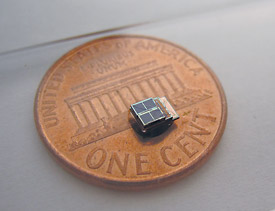A 9-cubic millimeter solar-powered sensor system developed at U-M is the smallest that can harvest energy from its surroundings to operate nearly perpetually.

A 9-cubic millimeter solar-powered sensor system developed at U-M is 1,000 times smaller than comparable commercial counterparts. Photo by Daeyeon Kim.
The system’s processor, solar cells and battery are all contained in its tiny frame, which measures 2.5 by 3.5 by 1 millimeters. It is 1,000 times smaller than comparable commercial counterparts.
The system could enable new biomedical implants as well as home-, building- and bridge-monitoring devices. It could vastly improve the efficiency and cost of current environmental sensor networks designed to detect movement or track air and water quality.
With an industry-standard ARM core, the system contains the lowest-powered commercial-class microcontroller. It uses about 2,000 times less power in sleep mode than its most energy-efficient counterpart on the market today.
ARM is the most popular processor architecture in cell phones and mobile devices. The Michigan system isn’t designed for cell phones, but the engineers say successful use of an ARM core is an important step toward commercial adoption of their technology.
Greg Chen, a computer science and engineering doctoral student, will present the research Tuesday at the International Solid-State Circuits Conference in San Francisco.
“Our system can run nearly perpetually if periodically exposed to reasonable lighting conditions, even indoors,” says David Blaauw, an electrical and computer engineering professor. “Its only limiting factor is battery wear-out, but the battery would last many years”
The sensor spends most of its time in sleep mode, waking briefly every few minutes to take measurements. Its total average power consumption is less than 1 nanowatt. A nanowatt is one-billionth of a watt.
The developers say its key innovation is their method for managing power. The processor only needs about half of a volt to operate, but its low-voltage, thin-film Cymbet battery puts out close to 4 volts. The voltage, which is essentially the pressure of the electric current, must be reduced for the system to function most efficiently.
“If we used traditional methods, the voltage conversion process would have consumed many times more power than the processor itself uses,” says Dennis Sylvester, an associate professor in electrical and computer engineering.
One way the U-M engineers made the voltage conversion more efficient is by slowing the power management unit’s clock when the processor’s load is light.
“We skip beats if we determine the voltage is sufficiently stable,” Sylvester says.
The designers are working with doctors on potential medical applications. The system could enable less-invasive ways to monitor pressure changes in the eyes, brain and in tumors in patients with glaucoma, head trauma or cancer. In the body, the sensor could conceivably harvest energy from movement or heat, rather than light, the engineers say.
The inventors are working to commercialize the technology through a company led by Scott Hanson.
The paper is entitled “Millimeter-Scale Nearly Perpetual Sensor System with Stacked Battery and Solar Cells.”
This research is funded by the National Science Foundation, the Defense Advanced Research Projects Agency, the National Institute of Standards and Technology, ARM Holdings, and the Focus Center Research Program.

